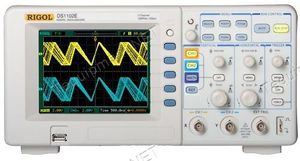Equipment/Rigol DS1052E: Difference between revisions
(Created page with "300px|thumb|right|Rigol DS1052E ==What== Rigol DS1052E 1GSa/s 50MHz 8 bit 2-channel with 1 megasample storage. FFT, USB. (storage and sampling ...") |
(No difference)
|
Revision as of 19:07, 22 January 2014
What
Rigol DS1052E 1GSa/s 50MHz 8 bit 2-channel with 1 megasample storage. FFT, USB.
(storage and sampling shared over 2 channels, so 500MSa/s 500k samples in 2 channel mode)
How?
The oscilloscope was made available to us by Bob (b3cft) at a substantial discount despite being in new condition. It was paid by pledge and available from january 2014. Akki14 found a convenient case to keep it safe & tidy at a camera show.
Hacking
It's widely known that this oscilloscope can be hacked to operate to the same spec as the 100Mhz DS1102E model. The hack involves downgrading to earlier firmware, executing some (subsequently disabled) remote control commands, and then upgrading again. There is a small, but not insignificant possibility of bricking, and also the possibility, not guaranteed, of recovering the bricking.
There is evidence that the modification is actually worthwhile : there is some programmable control of the front end which does indeed raise the bandwidth. The 1GSa/s limit is not changed, of course, but the display permits a higher maximum scan rate. Since the 1GSa/s limit is over both channels, this is only really useful in single channel mode : Despite Nyquist's theorum, in 2-channel mode the 500MSa/s sample rate is only really enough for 50MHz (10x bandwidth is usually the rule for reasonable fidelity on current DSOs). This is especially true of FFT mode.
There may be some uses for the DSO which would make this worth doing. However, it's at the limit of operation, and many needs for higher bandwith don't also require storage. If you have a need for 100MHz, note that we have an excellent, working, 275MHz HP1725A. This will do a far better job unless you have a simultaneous need for the storage or maths capabilities. Please seek the permission of the people who paid for the instrument before taking the (relatively low) risk involved in modifying it.
